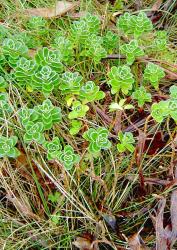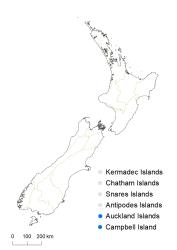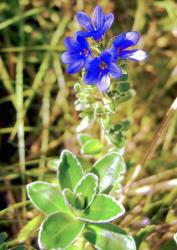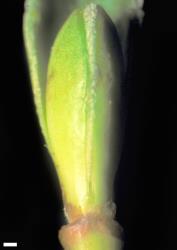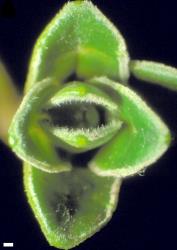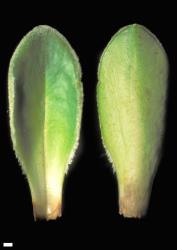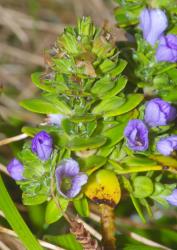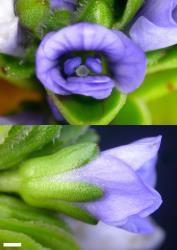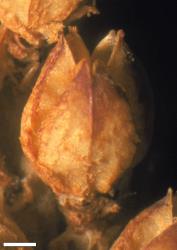- ≡ Hebe benthamii (Hook.f.) Cockayne & Allan, Trans. New Zealand Inst. 57: 43 (1926) – as benthami
- ≡ Leonohebe benthamii (Hook.f.) Heads, Bot. Soc. Otago Newsl. 5: 7 (1987)
- = Veronica finaustrina Hombr. & Jacquinot, Voy. Pôle Sud, Bot. Plate 9, Fig. y (1845)
Shrub to 1 m tall. Stems decumbent or ascending, eglandular-pubescent or glabrous; hairs bifarious. Leaf bud indistinct; leaves separating while small, opposite-decussate, shortly connate and encircling stem, erecto-patent to spreading or reflexed; lamina coriaceous, elliptic to obovate, 10–33 mm long, 3.5–14.5 mm wide, dull to somewhat glossy green above, dull green beneath; midrib evident; surfaces with eglandular hairs along midrib and near margins above, sometimes with scattered long hairs above; margin ciliate in a dense, tangled, fringing band of long, white, eglandular and very short glandular hairs, shallowly crenate to bluntly serrate or rarely entire; teeth in 1–6 pairs; apex obtuse to truncate; base cuneate to sub-cordate; petiole 1–2 mm long. Inflorescence a terminal raceme or rarely compound raceme, 30–80 mm long; flowers crowded, 10–22, or more in compound racemes, all bisexual; bracts opposite-decussate, obovate or sometimes elliptic, > pedicels; pedicels erecto-patent to spreading, 1–6 mm long, eglandular-hairy all around or glabrous. Calyx lobes 4–6, obtuse or sub-acute, 4.5–8.5 mm long, unequal, densely eglandular-ciliate on margins with minute glandular hairs as well. Corolla 7–12 mm diameter; tube pale to dark blue or purplish, 2.0–3.2 mm long, < calyx, glabrous; lobes 4–6, pale to dark blue or purplish, erect to spreading, equal to sub-equal, elliptic, obovate, or orbicular, 4–6 mm long, obtuse or posterior lobe sometimes emarginate; nectar guides absent although veins sometimes visible. Stamen filaments blue, 1–2 mm long; anthers blue to purplish. Style glabrous, 2.5–4.0 mm long. Capsules latiseptate or trigonous, acute or sub-acute, glabrous, 4–8 mm long, 4–6 mm at widest point. Seeds broadly ellipsoid to discoid, flattened, smooth, straw-yellow to dark brown, 1.2–1.9 mm long.
Veronica benthamii is unusual and distinctive. The plants have bluntly toothed to crenate leaf margins with a thick band of dense, tangled hairs, blue to purplish flowers, and often 3-locular ovaries and capsules. There are no other species with this combination of characters and nothing else that looks remotely similar, especially on the Auckland Is. and Campbell I. / Motu Ihupuku, where it grows.
Auckland Is. (Adams I., Auckland I., Disappointment I.), Campbell I. / Motu Ihupuku. Widespread and common.
Sub-alpine tussock grassland, low scrub, and often on steep and rocky slopes. Recorded elevations range from 90 to 495 m.
Flowers: October–May (mostly November–February); fruits: November–June, and persisting all year.
2n = 40 (see Bayly & Kellow 2006, as Hebe benthamii).
Veronica benthamii is classified in V. subg. Pseudoveronica sect. Hebe and the informal group “Connatae” (Albach & Meudt 2010; Bayly & Kellow 2006). Chloroplast DNA sequence data place V. benthamii within the shrubby hebe clade, and date that clade as 3.9 million years old (Wagstaff et al. 2002). Within that clade, ITS sequence data place V. benthamii with high support as sister to most of the rest of the clade, as sole species of a lineage that is probably close to that inferred age. Those findings also support the view (Heads 1987) that V. benthamii is not closely related to the core of the informal group “Connatae” (i.e., V. epacridea, V. haastii, V. kellowiae, V. macrocalyx).
The dense band of fringing hairs along the margins of leaves and bracts is quite distinctive and otherwise seen to this extent only in V. elliptica, which has entire leaves. Other species, also with entire leaves, have marginal hairs: in V. notialis the hairs are often branched, in V. obtusata they are not as dense, and in V. gibbsii they are longer and the leaves are very glaucous. V. benthamii leaves are shortly connate in pairs, and the portion where the margins join is often persistent as a little forked stump when the rest of the leaves have fallen. The bracts are often quite leaf-like, especially the lower ones, which may be toothed.
In many flowers the ovary and resulting capsules are 3–locular, a very unusual feature in the family. The calyx and corolla often have more than 4 lobes.
Based on specimens at WELT and CHR, it seems that the capsules of V. benthamii on Campbell I. / Motu Ihupuku are smaller than on the Auckland Is., and the few photos I have seen suggest flowers are smaller there too. The type specimens of both available names are from the Auckland Is.
| Auckland Is. | Campbell I. |
|---|---|---|
Inflorescence | elongated with sterile bracts at base | compact, without sterile bracts |
Capsule length (mm) | 5–8 | 4.0–6.5 |
Capsule width (mm) | 4–6 | 3–5 |



